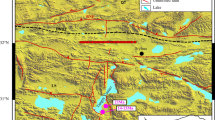Abstract
Through the analysis and 2-D inversion for the 5 profiles in Haiyuan arcuate tectonic region (105°–107°E, 36°–37.5°N) in the northeastern margin of Qinghai-Xizang Plateau, we have obtained the electric structure within a range of 160 km in width (east-west) and 60 km in depth in the studied area. The results show that the crustal electric structure can be divided into 6 sections, corresponding respectively to Xiji basin (I), Xihuashan-Nanhuashan uplift (II), Xingrenbu-Haiyuan basin (III), Zhongwei-Qingshuihe basin (IV), Zhongning-Hongsibu basin (V) and west-margin zone of Ordos (VI) from the southwest to the northeast. The crustal electric structure is characterized by a broom-shaped pattern, which scatters to the northwest and shrinks to the southeast. The structures in the top part of Haiyuan arcuate tectonic region are complete and large, however, they diminish from the arc top to the northwest and southeast ends. In the depth from 0 km to 10 km, the resistivity is high in the sections II and VI, but relatively low in the other four sections, showing a similar pattern of basin depression. The electrical basement in the section III is the deepest, displaying a “dustpan” shape that is deep in the southwest and shallow in the northeast. A series of discontinuous zones with high conductivity exist in the middle-lower crust in Haiyuan arcuate tectonic region, which is possibly related to the moderate and strong earthquakes in the region. The resistivity distribution in the focal area of the 1920 Haiyuan earthquake is significantly heterogeneous with an obviously high conductivity zone near the hypocenter regime.
Similar content being viewed by others
References
Bai Denghai, Maxwell A Meju, Liao Zhijie. 2001. Magnetotelluric images of deep crustal structure of the Rehai geothermal filed near Tengchong, Southern China [J]. Gephys J Int, 147: 677–687.
CHEN Le-shou and WANG Guang-e. 1990. Magnetotelluric Sounding Method [M]. Beijing: Geological Publishing House, 121–123 (in Chinese).
DENG Qi-dong, ZHANG Wei-qi, WANG Yi-peng et al. 1987. Main features of Haiyuan fault zone and 1920 Haiyuan earthquake faults and their formation mechanism [A]. In: JIANG Hao-xuan ed. Research on Recent Crustal Movement (3) [C]. Beijing: Seismological Press, 9–25 (in Chinese).
DENG Qi-dong, ZHANG Wei-qi, ZHANG Pei-zhen et al. 1989. Haiyuan strike-slip fault zone and its compressional structures of the end [J]. Seismology and Geology, 11(1): 1–14 (in Chinese).
Gamble T D, Goubau W M, Clarke J. 1979. Magnetotellurics with a remote reference [J]. Geophysics, 44(1): 53–68.
Institute of Geology, State Seismological Bureau and Seismological Bureau of Ningxia Hui Autonomous Region. 1990. Haiyuan Active Fault [M]. Beijing: Seismological Press, 1–2, 34–38 (in Chinese).
LI Song-lin, ZHANG Xian-kang, ZHANG Cheng-ke et al. 2001. Study on crust structure of Haiyuan strong earthquake region [J]. Chinese J Geophys, 17(1): 16–23 (in Chinese).
MA Zong-jin, WANG Yi-peng, ZHANG Yan-ping. 2001. Foreword [A]. In: MA Zong-jin, WANG Yi-peng, ZHANG Yan-ping ed. Study on the Recent Deformation and Dynamics of the Lithosphere of Qinghai-Xizang Plateau [C]. Beijing: Seismological Press, 251–262 (in Chinese with English abstract).
MIN Wei. 1988. Tectonic Evolution of the Xiangshan-Tianjingshan Fault Zone and Forming Mechanism of Compressional Structures in the Strike-slip Fault Zone End [D]: [MS Dissertation]. Beijing: Institute of Geology, State Seismological Bureau, 1–33 (in Chinese).
MIN Wei, ZHANG Pei-zhen, DENG Qi-dong et al. 2001a. The study of Holocene paleoearthquakes on Zhongwei-Tongxin fault zone [J]. Seismology and Geology, 23(3): 357–366 (in Chinese).
MIN Wei, ZHANG Pei-zhen, DENG Qi-dong et al. 2001b. Detailed study of Holocene paleoearthquakes of the Haiyuan active fault [J]. Geological Review, 47(1): 75–81 (in Chinese).
QU Jian-peng, ZHU Zuo-quan, YANG Guo-dong et al. 1998. Analysis on electrical structure of crust and upper mantle along the western border of Ordos block [J]. Northwestern Seismological Journal, 20(2): 70–75 (in Chinese).
Smith J T and Booker J R. 1991. Rapid inversion of two- and three-dimensional magnetotelluric data [J]. J Geophys Res, 96: 3 905–3 922.
TIAN Qin-jian. 1998. Evolution of the Laolongwan Pull-apart Basin and Strike-slipping of the Haiyuan Fault Zone [D]: [PhD Dissertation]. Beijing: Institute of geology, State Seismological Bureau, 45–101 (in Chinese).
TIAN Qin-jian, DING Guo-yu, SHEN Xu-hui. 2002. Seismic tectonic model of the northeastern corner of the Tibet plateau [J]. Earthquake, 22(1): 9–16 (in Chinese).
WANG Yi-peng. 1998. Main point of the kinematic model of the Qinghai- Xizang Plateau developed by P. Tapponnier and review on the model [J]. Recent Developments in World Seismology, 229: 9–14 (in Chinese).
XU Xi-wei, YU Gui-hua, MA Wen-tao et al. 2003. Model of latest crustal tectonic motion of the central tectonic zone on the mainland of China [J]. Earth Science Frontiers, 10(Suppl.): 160–167 (in Chinese).
XU Yi, LIU Fu-tian, LIU Jian-hua et al. 2000. Crustal structure and tectonic environment of strong earthquakes in the Tianshan earthquake belt [J]. Chinese J Geophys, 43(2): 184–193 (in Chinese).
YIN Xiu-hua, LI Yi-shi, LIU Zhan-po. 1999. Internal correspondence analysis of gravimetric and magnetic data for the northern part of south-north tectonic zone [J]. Seismology and Geology, 21(4): 370–376 (in Chinese).
ZHAN Yan, ZHAO Guo-ze, CHEN Xiao-bin et al. 2004. Crust structure from magnetotelluric profiling in the Haiyuan earthquake area in Ningxia Hui Autonomous Region [J]. Chinese J Geophys, 47(2): 274–281 (in Chinese).
ZHANG Jia-sheng, LI Yan, HAN Zhu-jun. 2003. Deformation responses to eastwards escaping of the Qinghai-Tibet plateau and tectonics of the south-north seismic zones in China [J]. Earth Science Frontiers, 10(Suppl.): 166–175 (in Chinese).
ZHOU Min-du, LÜ Tai-yi, ZHANG Yuan-sheng et al. 2000. The geological structure background and the crust structure in the northeastern margin of the Qinghai-Tibetan plateau [J]. Acta Seismologica Sinica, 22(6): 645–653.
Author information
Authors and Affiliations
Additional information
Foundation item: National Natural Science Foundation of China (40374032), State Key Basic Research Development and Programming Project (95-13-02-02) and Joint Seismological Science Foundation of China (102088).
About this article
Cite this article
Zhan, Y., Zhao, Gz., Wang, Jj. et al. Crustal electric structure of Haiyuan arcuate tectonic region in the northeastern margin of Qinghai-Xizang Plateau, China. Acta Seimol. Sin. 18, 460–470 (2005). https://doi.org/10.1007/s11589-005-0024-x
Received:
Revised:
Accepted:
Issue Date:
DOI: https://doi.org/10.1007/s11589-005-0024-x



